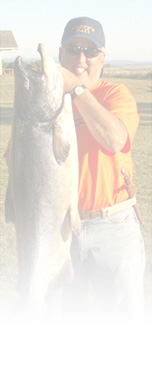If you’re an outside person like me, you’ve recently observed enduring the coolest, wettest summer in 30 years. Just like southern California, but different.
The article went on to say, expect above average rainfall, increased snow pack and lower temperatures until spring. Sounds like the summer of 2010.
While we attempt to understand why we live here, especially in the months ahead, salmon are happy campers when Mother Nature delivers La Nina conditions.
Starting with summer, the northwest winds blow on the ocean, creating incredible upwelling conditions as the northwest currents blast the continental shelf, producing megatons of zooplankton and phytoplankton onto the coastal pasture, setting the table for northwest salmon stocks, fattening up for a northern migration, while passing their adult relatives, heading south, on their way home. While the plankton produces the right food for salmon smolts and baitfish, such as herring, anchovies and sardines, the entire food chain benefits producing greater survival rates for the next few years.
Mark Cedergreen, who represents the Westport Charterboat Association and resides in the Westport community, knows about La Nina and El Nino conditions. He has witnessed the poorest of ocean salmon survival rates as the result of warm ocean waters produced by El Nino conditions. And more recently, he has monitored high ocean salmon survival rates from La Nina conditions.
Earlier last month, I spent a few days salmon fishing in the ocean out of Westport. In two days of fishing, an Olympia fishing buddy, Greg Kluh and I estimated we hooked around 90 big Coho salmon, along with a dozen kings. It was Nirvana. At the end of the second day, I declared, “I’m done.” It was time to head back home, hang upside down in the closet for 48 hours, and return to daily life. It was a couple of salmon fishing days memories are made of.
During that fishing trip, Greg and I could not escape tough, fat young Chinook salmon from 6-10 pounds. “Don’t fish under 30 feet,” I said to Greg, “or one of these pest Chinook will eat you.” Thick as fleas.
One of those evenings, in talking to Mark Cedergreen, he suggested that the La Nina conditions will likely produce another great Chinook summer, hopefully similar to this year. Make my day.
Therefore, in summary, while we listen and live to the driving cold rain this fall and winter, you are right... La Nina, baby. However, focus on the payday of next summer, when the kings of 2011 are heading home. Nirvana, all over again!
The Big Crab Vote
Today is a very important day, for recreational crab fishers in Puget Sound. After four years of consideration, data collecting, listening to crab biologists, sport and commercial crab fishermen, along with a few legislators, the Washington Fish and Wildlife Commission will vote on one of three options (A, B or C) designed to adjust the allocation of Puget Sound crab.
The road to this day, and this vote, has been long and challenging, as the Commission will likely endure the wrath of the commercial industry if the sport crab fishing season is expanded, or the sport crabbers will scream injustice if the vote is anything less than the preferred option A, providing more fishing opportunity for sport crabbing. It is a good day not to be a Fish and Wildlife Commissioner.
As you may recall in previous writings, Governor Gregoire, in meeting with sport fishing organized groups, vowed to recognize the growing economic importance of sport fishing in Washington, which includes the crab fishery in the comparatively calmer waters of Puget Sound. Statistically, at last count, there are about 235,000 sport crab license holders in Puget Sound. Commercially, the number is around 200. Sound like a no brainer? Will the Commission, appointees of Gov. Gregoire and her platform have the courage to do the right thing? Or, will they back down to legislators who threaten their existence on the Commission. It’s political as usual and the outcome will be public following the vote at 10 a.m. on Friday, October 1.
In the meantime, October is a time of change. Mature Chinook and most adult Coho salmon have cleared marine waters and are preparing to make their offerings to perpetuate their stocks in the streams and rivers of their origins. For freshwater anglers, October is prime time to do business with these migrating fish as they enter the last chapter of life.
For this cat, I’ll continue to sniff the waters of Grays Harbor, attempting to intercept jumbo Coho salmon bound for the Chehalis River system. The South Channel, along with the North Channel, up to the mouth of the Little Hoquiam River has been good to me in recent years during October.
Following October and Grays Harbor, it’s back to late fall and winter blackmouth fishing in Puget Sound and the cycle repeats itself, year after year after year.
So chin up, rain gear on and get ready for a long, gray and wet fall/winter. Don’t expect it to slow me down. So many fish and so little time. See you on the water.


